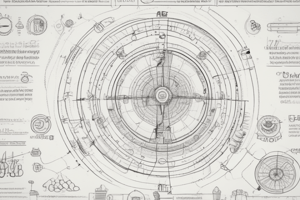Podcast
Questions and Answers
What is one of the primary goals of a questionnaire in research?
What is one of the primary goals of a questionnaire in research?
- Collect needed data (correct)
- Minimize costs
- Increase the number of questions
- Enhance subjectivity
Which step comes first in the questionnaire design process?
Which step comes first in the questionnaire design process?
- Question layout and recruiting message
- Specify the information needed (correct)
- Pre-testing
- Determine survey method
Which of the following methods is NOT part of the questionnaire design process?
Which of the following methods is NOT part of the questionnaire design process?
- Data categorization (correct)
- Question structure/sequence
- Question content
- Recruiting message
What does the conceptual model in research typically summarize?
What does the conceptual model in research typically summarize?
What is a benefit of a well-designed questionnaire beyond data collection?
What is a benefit of a well-designed questionnaire beyond data collection?
What is a key criterion for evaluating survey methods?
What is a key criterion for evaluating survey methods?
Which survey method maximizes the potential for sample control?
Which survey method maximizes the potential for sample control?
What approach is recommended to improve data quality?
What approach is recommended to improve data quality?
Which of the following questions contains a leading question bias?
Which of the following questions contains a leading question bias?
What is an example of a filler question?
What is an example of a filler question?
Which type of question is most likely to yield biased answers due to its wording?
Which type of question is most likely to yield biased answers due to its wording?
Which survey method has the highest potential for interviewer bias?
Which survey method has the highest potential for interviewer bias?
Which of these is NOT a way to improve survey question clarity?
Which of these is NOT a way to improve survey question clarity?
What is a recommended length for survey questions?
What is a recommended length for survey questions?
What type of questions should be asked first in a survey?
What type of questions should be asked first in a survey?
What aspect should be emphasized when asking about purchase likelihood?
What aspect should be emphasized when asking about purchase likelihood?
In which section of a survey are demographic questions typically placed?
In which section of a survey are demographic questions typically placed?
What is a key benefit of pre-testing a questionnaire?
What is a key benefit of pre-testing a questionnaire?
What may help improve response rates during survey participation?
What may help improve response rates during survey participation?
What task should be done after pre-testing a questionnaire?
What task should be done after pre-testing a questionnaire?
What is considered a potential source of order bias in surveys?
What is considered a potential source of order bias in surveys?
Study Notes
Objectives of a Questionnaire
- Translate research objectives into specific questions.
- Primary goals include collecting necessary data and minimizing error.
- Additional benefits: act as a permanent record, facilitate data analysis, and gather information for reliability measures.
Questionnaire Design Process
- Specify the information needed based on research problems and exploratory research input.
- Determine the survey method suitable for the target population.
- Develop question content to address the identified needs.
- Structure and sequence questions logically.
- Design question layout and create a recruiting message to engage participants.
- Conduct pre-testing to identify issues and refine the questionnaire.
Specifying the Information Need
- Inputs for specifying information include defining research problems and insights from exploratory research.
- Summarize findings in a conceptual model, illustrating the relationship between independent (X) and dependent (Y) variables.
Survey Method Determination
- Consider various survey methods: Personal (in-home, CAPI), Mail (PAPI, mail panel), Telephone (CATI), and Internet (web surveys, web panels).
- Evaluate methods based on cost, time, response rate, sample control, bias potential, quantity of data, question diversity, and use of physical stimuli.
Enhancing Data Quality
- Implement incentive-aligned survey designs and employ filler questions.
- Utilize attention check questions to filter out unengaged respondents.
- Provide specific instructions for answering questions, including open-ended responses.
Question Content Considerations
- The phrasing of questions can significantly influence responses and conclusions.
- Wording effects illustrate how the formulation of a single question can yield different responses based on context.
Question Sequence Strategy
- Start with qualifying questions (screeners) to identify target respondents.
- Warm-up questions should be simple to ease respondents into the survey.
- Focus questions require more effort and should be positioned after warm-ups.
- Position demographic and sensitive questions at the end to avoid biasing responses.
Addressing Order Bias
- Research demonstrates that the order of questions affects responses, as seen in studies where the sequence of questions altered responses even if the content was the same.
Layout and Recruiting Message Importance
- The survey's physical appearance influences participation and completion rates.
- Include an introduction that outlines the survey purpose, selection criteria for participants, confidentiality assurances, and a thank-you note to respondents.
Pre-Testing Essentials
- Conduct pre-testing with a small representative sample to ensure clarity and flow of questions.
- Pay close attention to the duration taken by respondents to complete the survey, which can indicate issues with question length or difficulty.
Studying That Suits You
Use AI to generate personalized quizzes and flashcards to suit your learning preferences.
Related Documents
Description
Explore the key principles of survey design in marketing research. This quiz covers different types of measurement scales, formulation of research problems, and the objectives of creating an effective questionnaire. Enhance your understanding of data collection techniques and analytical interpretation.




